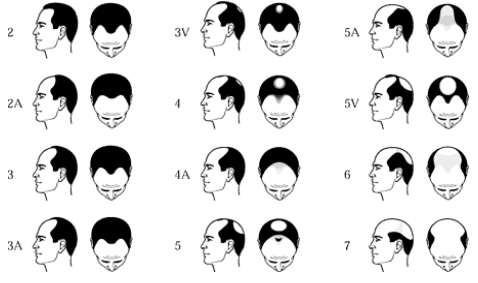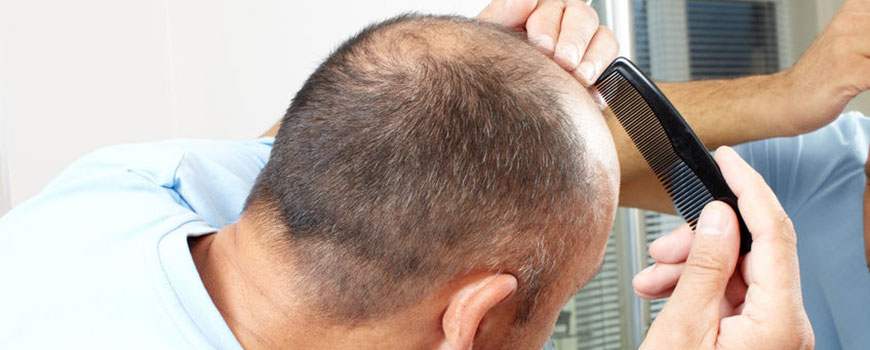What is Hair Miniaturization and What Can I Do About It?
What Is Hair Miniaturization?
Hair miniaturization is a natural process that occurs in 95% of all hair loss cases. It’s the starting point from which male pattern baldness occurs. Individual follicles and strands shrink over time, then become dormant and eventually scar over if left untreated.
Hair miniaturization is the key feature of Pattern Hair Loss or Androgenic Alopecia. It affects many men starting in their early 20’s as puberty comes to an end. The hair will appear less dense and thinner before it eventually falls out.
The onset of male pattern baldness begins with miniaturization and ends with fibrosis (or scarring) when the hair bulb and follicle disappear, but this process takes many years.
Miniaturization is what a person sees the first time he or she realizes they are losing their hair. If the person desires to save their hair and prevent further balding, now is the time to act.
What causes Hair Miniaturization?
Hair miniaturization can occur as a result of four different causes:
- Genetics
- Lack of nutrition
- Excessive levels of dihydrotestosterone (DHT)
- Age
Genetics
The #1 cause of hair loss and hair miniaturization is, unfortunately, genetics. If baldness or thinning hair runs in your family, then there is a good chance that you are going to have the same issues as you get older.
Unfortunately, since it’s your genetics that are causing your hair to fall out, there is no magic pill you can take to completely stop the process, but there are medications and procedures that can be use to slow down, or correct, the hair loss you may be experiencing.
Lack of Nutrition
Lack of proper nutrition can have negative effects upon hair growth. If the required nutrients aren’t delivered to the hair follicles, they can shrink and fall out.
Scientists have discovered that certain foods can inhibit DHT, a hormone linked to hair loss, which could help prevent the miniaturization of hair.
Foods like spearmint, green tea, flax/sesame seeds, and licorice are just a few DHT inhibitors that could provide some benefit if you notice your hair starting to thin. However, there is no guarantee that eating these types of food are going to help. Each situation is unique and should be discussed with your doctor.
It should also be noted that taking supplements alone cannot and will not cure male pattern baldness.
There are many companies that sell so called “anti-balding pills” in the unregulated supplement market, but there is no science to back up their claims. While “alternative medicine” may help to some extent, the best way to treat it is to visit a hair loss clinic for a professional diagnosis and prescription medication.
DHT
Scientists have linked the hormone DHT to hair loss, but what is DHT.
DHT, also known as dihydrotestosterone, is an androgen hormone that helps give males their male characteristics, such as deeper voice, body hair and muscle mass.
Testosterone in your body, enters your cells through specific receptors and gets converted into DHT, which is another reason why if you’re taking any sort of testosterone supplements, you may notice an increase in hair miniaturization.
When high levels of DHT occur in your cells, the hormone will send signals to your hair follicles, thereby causing them to shrink, stop growing, and eventually fall out. By limiting the DHT that the testosterone in your body produces, it can help slow down the process of hair miniaturization.
DHT mainly affects the frontal hairline, top and crown of the head. The backs and sides of the scalp are more immune to the unwanted effects of DHT. This is why men who suffer from severe male pattern baldness oftentimes retain the “horseshoe” of hair on the sides and back of their head, while their crown and front are completely bald. This is also why hair transplants are possible using the hair that remains in those areas, to help fill in the thinning areas on the top and front of the scalp.
Scientists and hair loss surgeons have come up with a scale to categorize the amount of hair loss. It’s called the Norwood scale and it demonstrates the various degrees of male pattern baldness.

Age
A person’s age can also influence the presence of hair miniaturization. The natural processes that regulate our bodies as we age tend to slow. As such, hair growth will also slow over time and some hairs are lost to simple aging, usually after age 60.
What can be done to help slow hair miniaturization?
Those who suffer from hair miniaturization want to know what can be done to slow or stop it. The good news is that there are several viable options available, several of which we’ve listed below.
You will still want to schedule an appointment with a nationally-recognized hair loss clinic to discuss exactly which method of treatment will work best in your situation. Everyone’s genetics and hair loss are different, so what may have worked for a friend or family member, may not be the best solution for you.
Hair Loss Medications
The FDA has approved hair loss medications such as Rogaine (Minoxidil) and Propecia (Finasteride) which can help slow and even reverse hair miniaturization in the early stages of hair loss. They can also increase the density of the hair.
Rogaine is FDA-approved for both men and women and can be purchased over the counter. It works in part by increasing blood flow to shrinking hair follicles to help promote hair growth.
Propecia works by preventing the conversion of testosterone to DHT specifically around susceptible hair follicles. As we mentioned previously, the reduction of DHT in the body can help reduce the effects of hair loss.
Saw Palmetto is an herbal remedy that has shown promise in helping treat hair loss in males. According to a study, saw palmetto shows signs of inhibiting the conversion of testosterone to DHT, similarly to how Propecia does. While this herbal remedy is not FDA approved, it may be a viable option for those seeking alternative medicines.
Hair Transplant Procedure
If hair miniaturization is excessive, then medications alone will not help restore the lost hair. At this point in time surgery is the only option to help restore your hair. There are several hair transplant methods available that can help restore hair in the balding areas.
A hair transplant procedure involves taking hairs from the back and sides of the head and transplanting them to the balding areas. Hair transplant science has advanced quite a bit over the years to the point where, as long as you’re working with an experienced hair loss specialist, you should have no noticeable scaring or an unnatural appearance on your scalp. There’s a very good change your hair will rejuvenate your look and make you feel better about yourself.
If you’re looking for a more permanent solution to help with your hair loss, then a hair transplant is going to be the best option.
Hair Miniaturization Options in San Antonio
If you’re experiencing the onset of hair miniaturization or think you may be suffering from male pattern baldness, schedule at appointment. At Limmer Hair Transplant Center, we’ve been helping transform the lives of our patients for over 30 years. Give us a call today to learn more how we can help stop the hair loss and restore your self-confidence.





